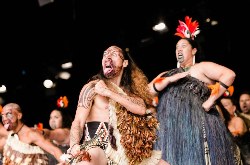World first: three-way HyperClass link
On 15 December 2000 a three-way link was successfully made in HyperReality between Waseda University in Japan, Victoria University of Wellington in New Zealand and the Queensland Open Learning Network in Australia.
The avatar of Dr Lalita Rajasingham handed a virtual CD-ROM to the avatar of Anne Gooley, Chief Executive of the Queensland Open Learning Network, in Australia who then handed it to the avatar of Professor Nobuyoshi Terashima at Waseda University in Japan who then fitted it into a virtual computer.
Simple as this sounds it is the accumulation of many years of collaborative research, and its implications are profound for the future of the information society.
Dr Nobuyoshi Terashima lead the research team at the Advanced Telecommunications Research Laboratories (Japan's premier futures research institute) which developed the technology known as HyperReality(HR). HyperReality is the interaction of virtual reality and physical reality and human intelligence and artificial intelligence. It makes possible a future where the people and the objects around you may be real or may be virtual and may have human intelligence or artificial intelligence.
Prof Emeritus John Tiffin and Dr Lalita Rajasingham of Victoria University have for the last 15 years been researching with their students the future of education. For much of this time they were supported by the technological expertise of Simon Lonsdale.
Their book In Search of the Virtual Class: Education in an Information Society made popular around the world the concepts of virtual schools and virtual universities on the Internet and attracted the interest of Professor Terashima who had become Dean of the Graduate School of Global Information and Telecommunications Studies at Tokyo's Waseda University. He saw the virtual class as an application for HyperReality.
Since 1993, the three researchers have been collaborating in the design and development of the HyperClass which is a combination of a real class and a virtual class, real people and virtual people and introduces artificial intelligence in education.
In December of 1998 they made the first HyperClass link between Waseda University and Victoria University of Wellington and have been conducting experiments since incorporating new technological advances. Prof Terashima is responsible for the technology, Prof Tiffin for the pedagogy and Dr Rajasingham for the communications issues.
Anne Gooley is founder and chief Executive of the Queensland Open Learning Network, Queensland's premier distance institution responsible for distributing secondary and tertiary education by telecommunications throughout Queensland and for leading -edge research into new technological developments. It was this that interested her in becoming involved in the HyperClass research Project.
Recent experiments established the feasibility of linking Queensland Open Learning Network with Waseda University and lead Professor Terashima to attempt the successful three way link between Japan, Australia and New Zealand.
At the moment the technology is in a very simple form. But the success of the experiment between the three countries means that one day it will be possible to hold classes between teachers and students who are physically present in different countries and to use artificial intelligence in education.
It makes
possible the idea of a HyperUniversity where universities
can link in virtual classes. The School of the Future at the
University of Sao Paulo in Brazil and Carnegie Melon
University have already expressed interest in being involved
in this
research.


 NZEI Te Riu Roa: Mandated Single Approach To Reading Will Not Work
NZEI Te Riu Roa: Mandated Single Approach To Reading Will Not Work The Conversation: Could The School Phone Ban Work?
The Conversation: Could The School Phone Ban Work? Public Health Communication Centre: To Avoid A Measles Epidemic, Aotearoa Must Close The ‘Immunity Gap’
Public Health Communication Centre: To Avoid A Measles Epidemic, Aotearoa Must Close The ‘Immunity Gap’ Heritage New Zealand: Kid-friendly Archaeology Resource Kit Launched As Part Of Archaeology Week
Heritage New Zealand: Kid-friendly Archaeology Resource Kit Launched As Part Of Archaeology Week Tatai Aho Rau Core Education: Cyber Skills Programme For Tamariki Recognised At Māori Language Awards
Tatai Aho Rau Core Education: Cyber Skills Programme For Tamariki Recognised At Māori Language Awards Waitaha Kapa Haka: Waitaha-South Island Kapa Haka Celebrates 60th Anniversary
Waitaha Kapa Haka: Waitaha-South Island Kapa Haka Celebrates 60th Anniversary